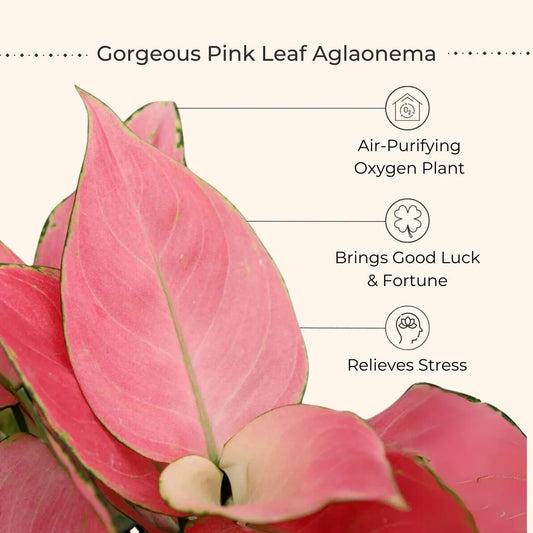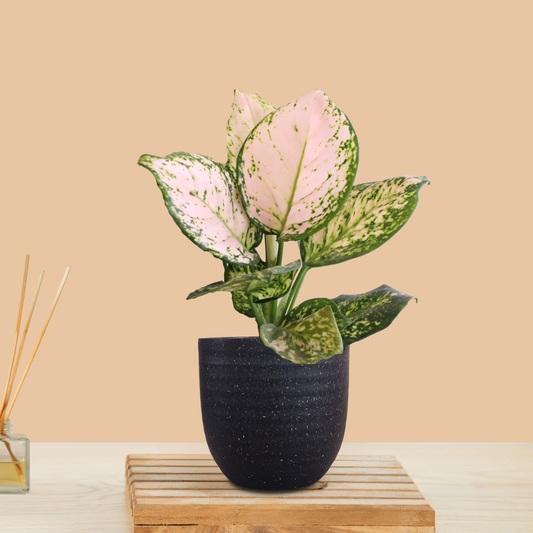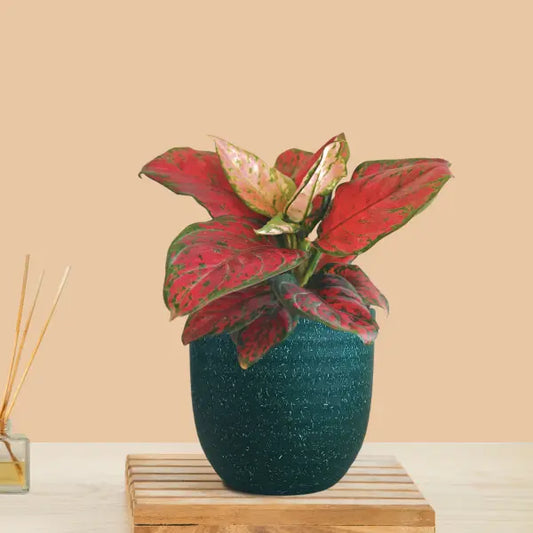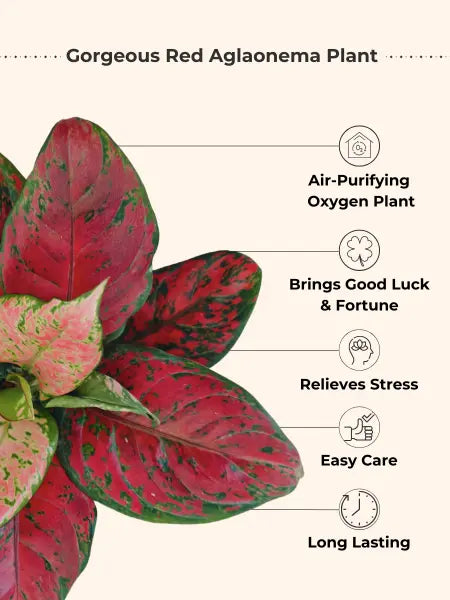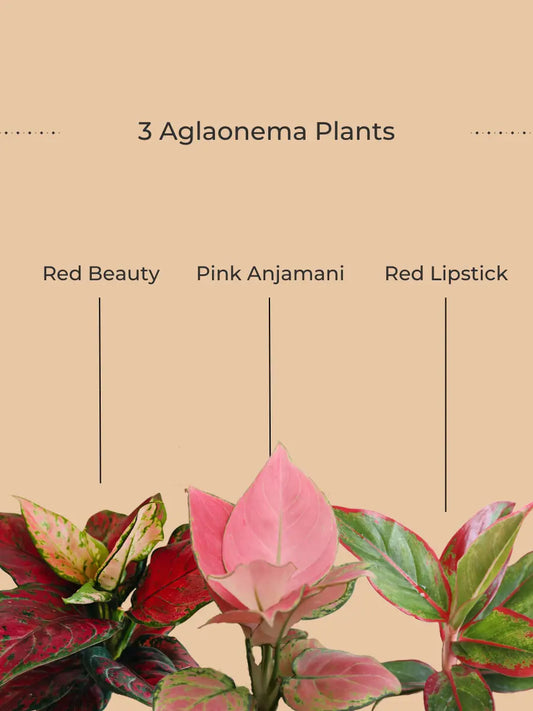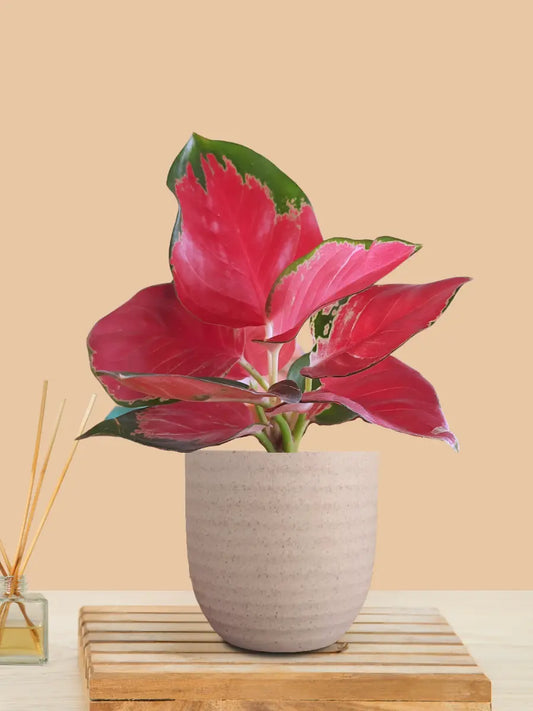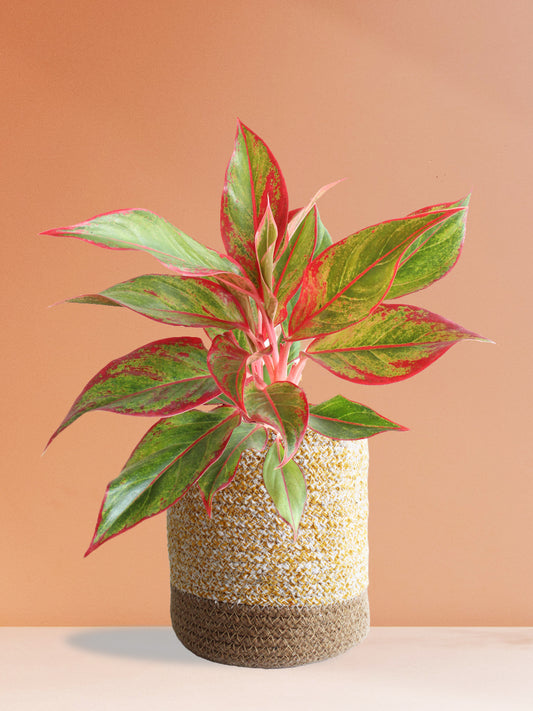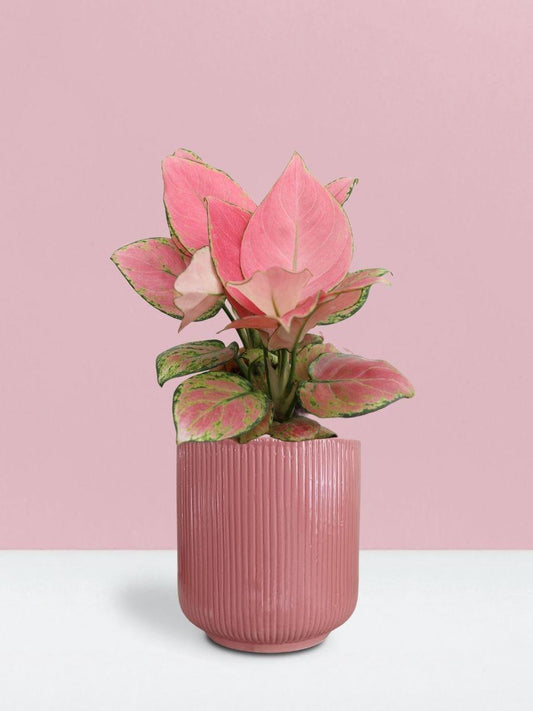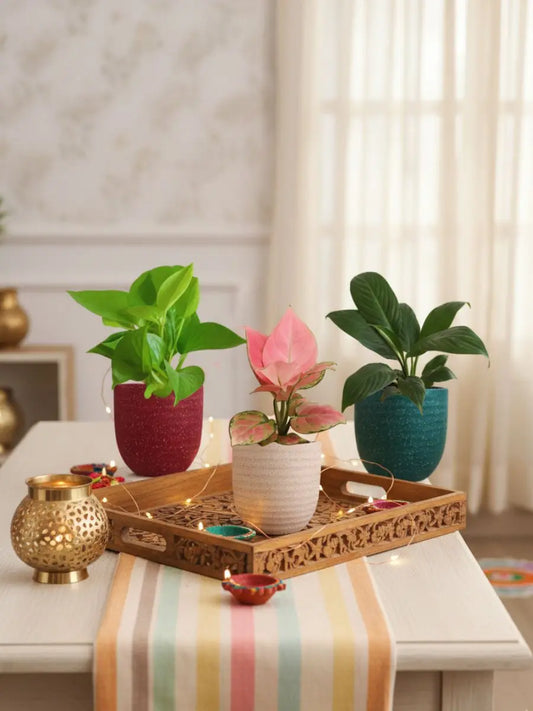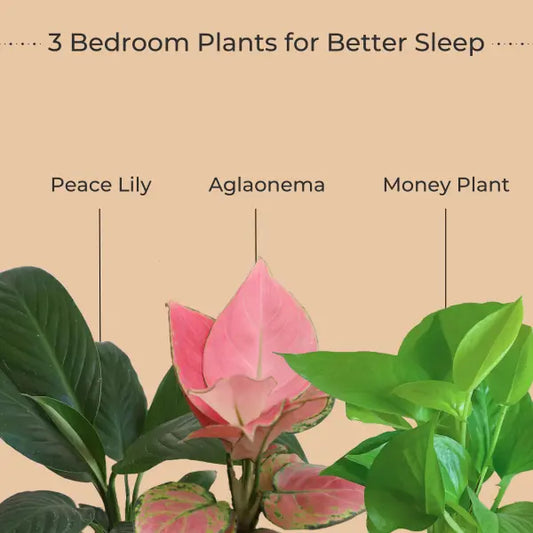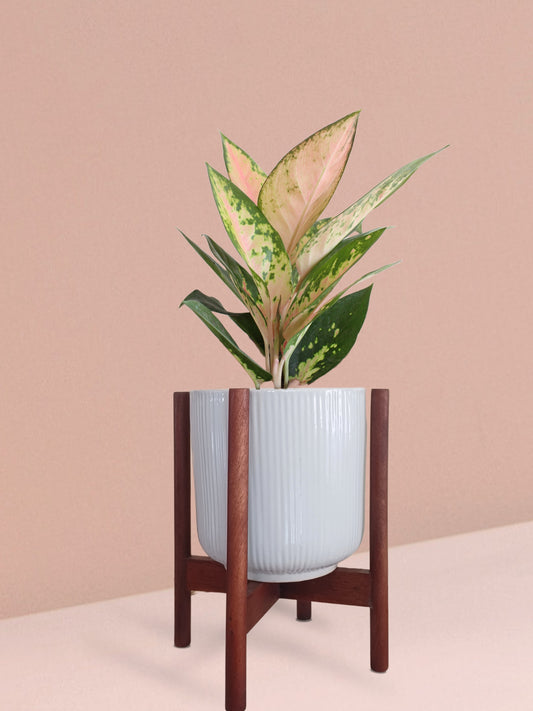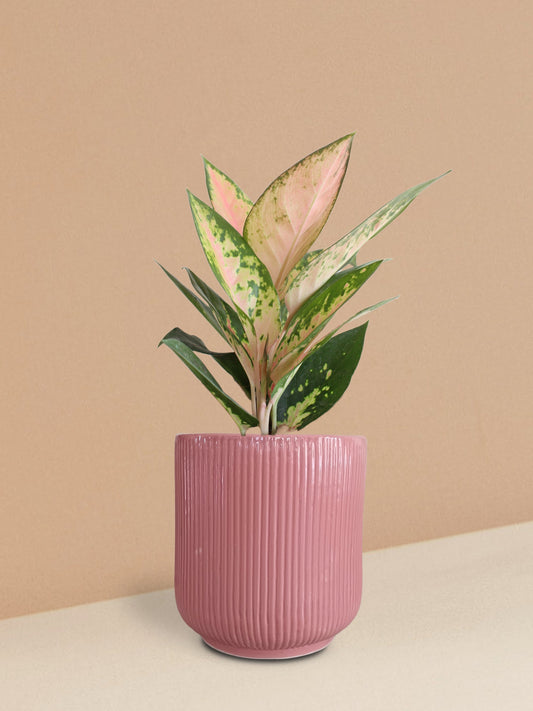
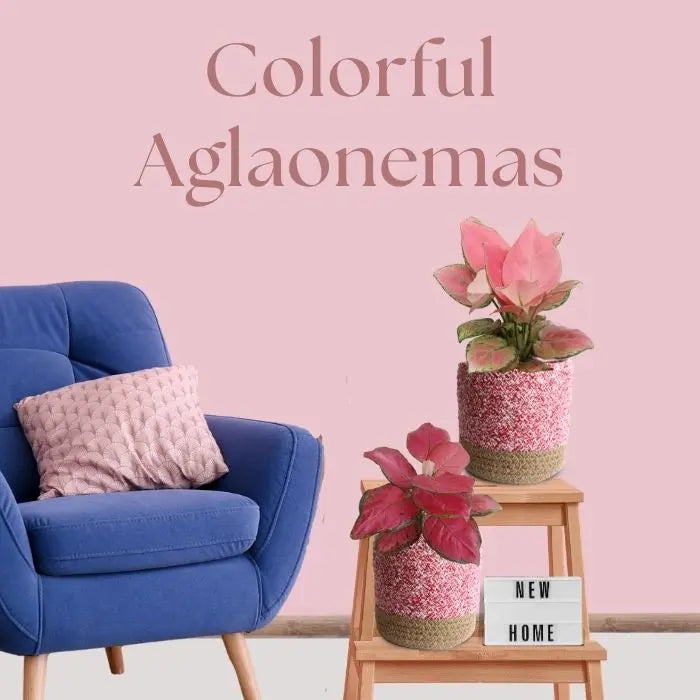
-
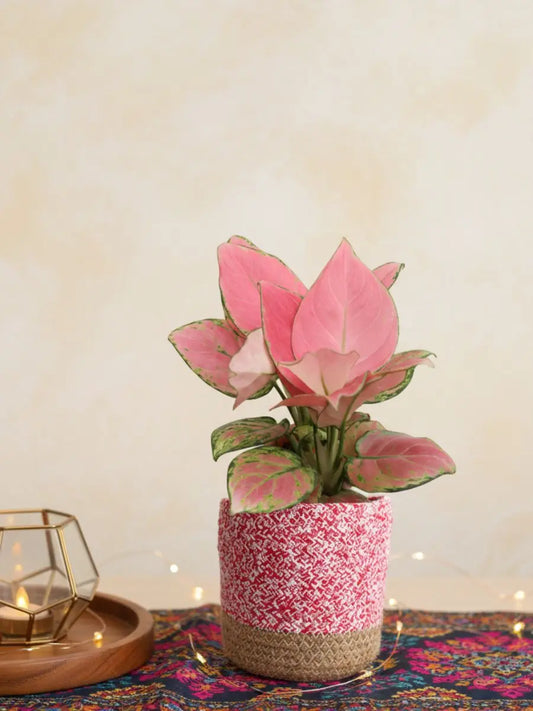
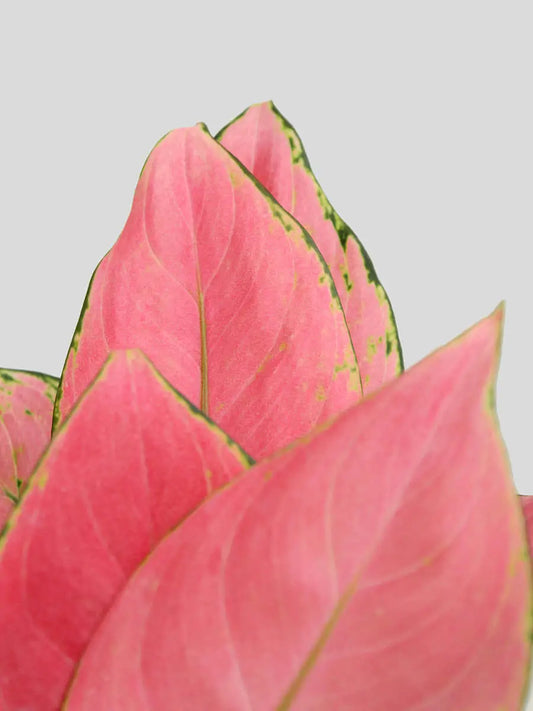 26% Off
26% OffAglaonema Pink Anjamani (Medium)
Regular price From ₹ 699Regular priceUnit price per₹ 949Sale price From ₹ 699Sale -
Aglaonema Pink Anjamani (Small) in Eco Pot
Regular price ₹ 559Regular priceUnit price per₹ 699Sale price ₹ 559Sale -
Aglaonema Pink Valentine (Small) in Eco Pot
Regular price ₹ 499Regular priceUnit price per₹ 699Sale price ₹ 499Sale -
Aglaonema Red Beauty (Small) in Eco Pot
Regular price ₹ 639Regular priceUnit price per₹ 799Sale price ₹ 639Sale -
Must Have Shades of Aglaonema Plants (Small)
Regular price ₹ 1,574Regular priceUnit price per₹ 2,099Sale price ₹ 1,574Sale -
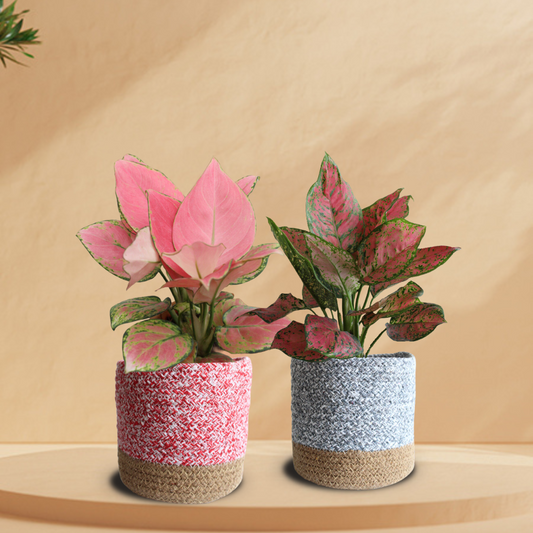
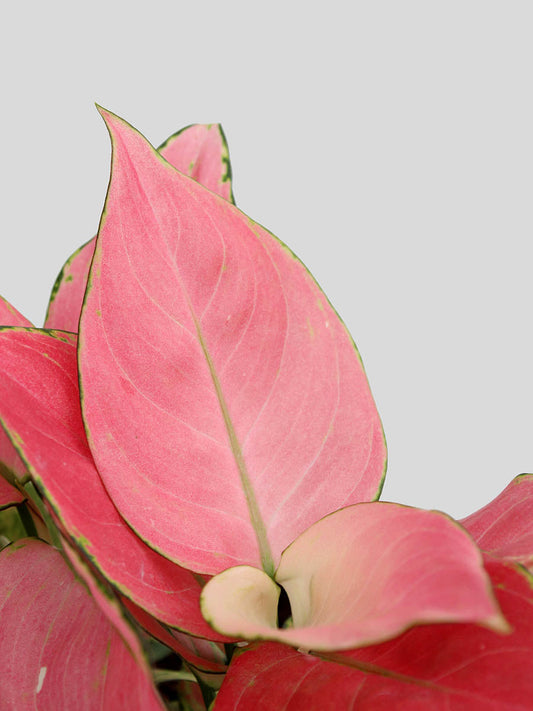 37% Off
37% OffLovely Pink Duo
Regular price ₹ 1,699Regular priceUnit price per₹ 2,699Sale price ₹ 1,699Sale -

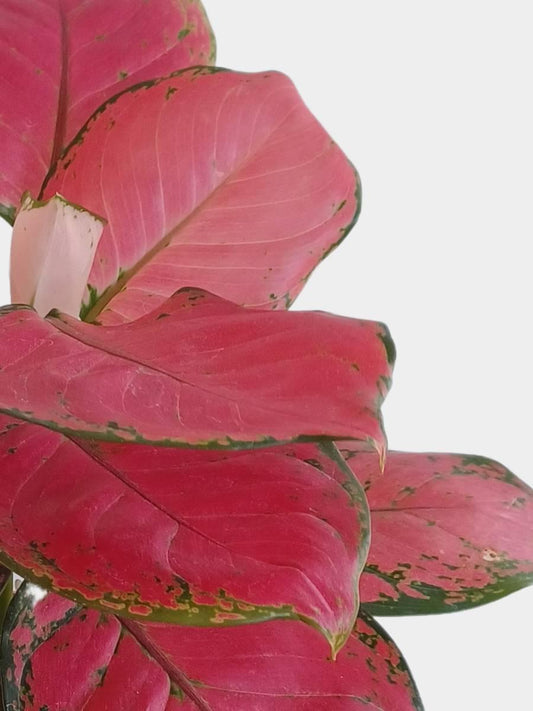 Sold out
Sold outAglaonema Red Ruby (Medium)
Regular price From ₹ 919Regular priceUnit price per₹ 1,149Sale price From ₹ 919Sold out -
Aglaonema Cherry Red Plant (Small) in Eco Pot
Regular price ₹ 699Regular priceUnit price per₹ 1,199Sale price ₹ 699Sale -
Colorful Air-Purifying Plants Combo for Bedroom
Regular price ₹ 4,724Regular priceUnit price per₹ 6,299Sale price ₹ 4,724Sale -
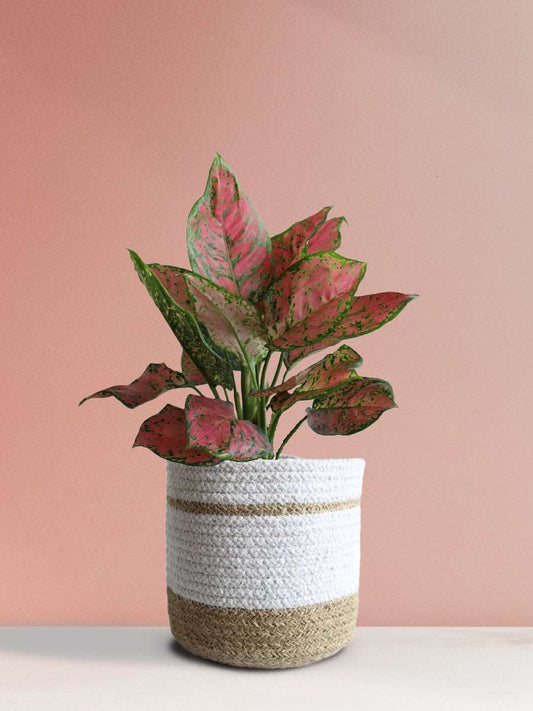
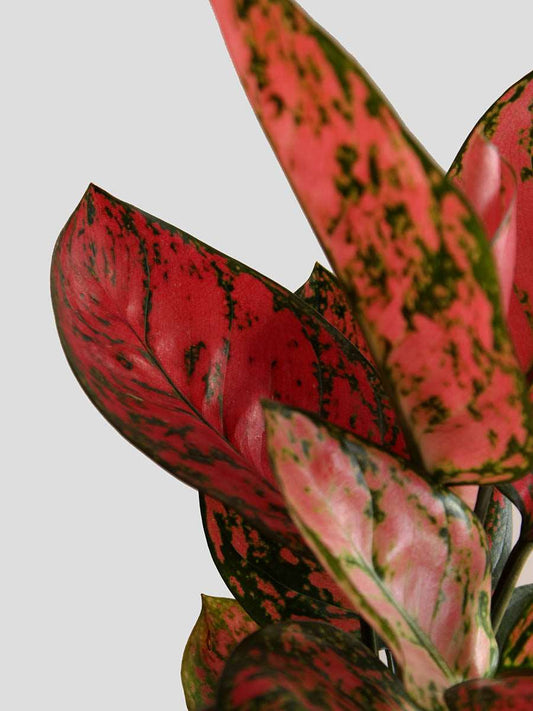 36% Off
36% OffAglaonema Red Valentine (Medium)
Regular price From ₹ 699Regular priceUnit price per₹ 1,099Sale price From ₹ 699Sale -
Aglaonema Pink Anjamani Plant in Ceramic Pot (Medium)
Regular price ₹ 2,039Regular priceUnit price per₹ 2,549Sale price ₹ 2,039Sale -
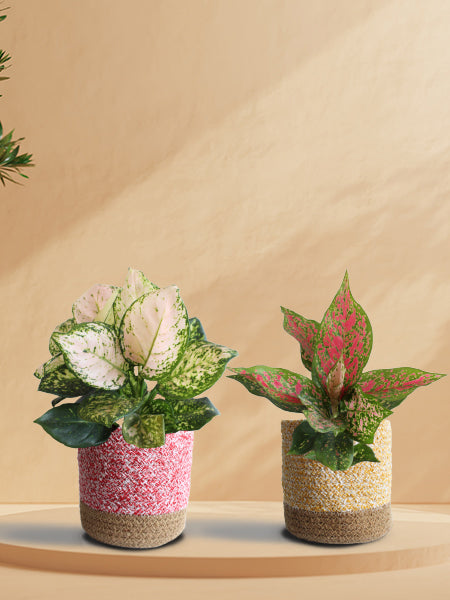
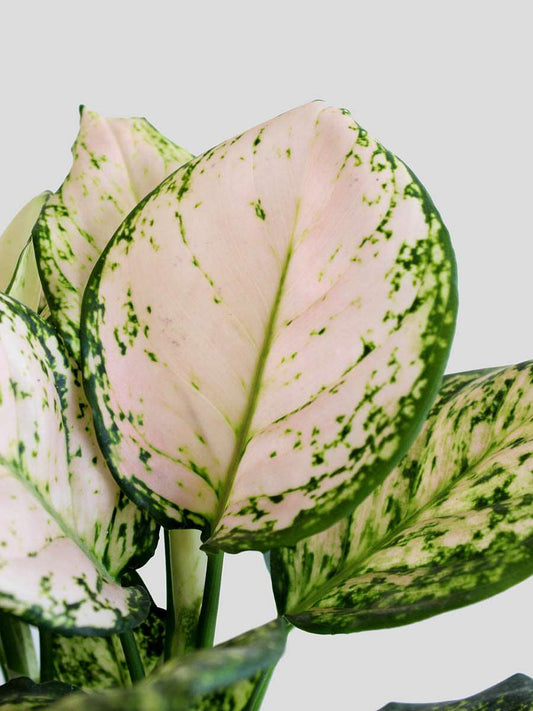 40% Off
40% OffBlushing Twins
Regular price ₹ 1,649Regular priceUnit price per₹ 2,749Sale price ₹ 1,649Sale -
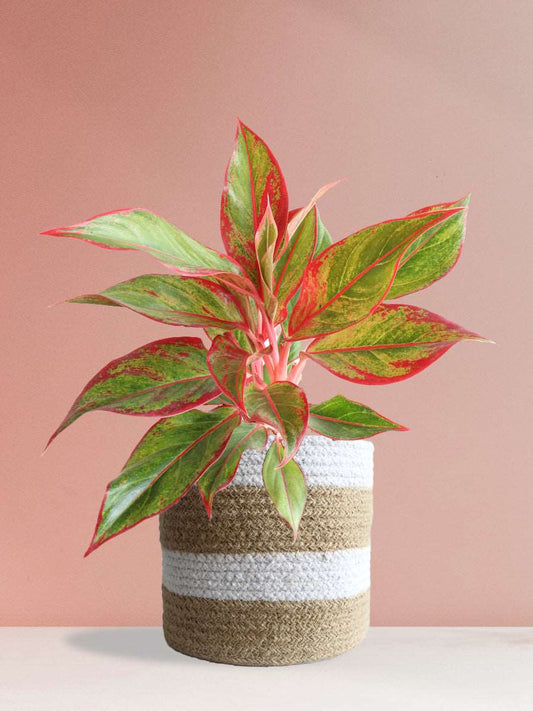
 Sold out
Sold outAglaonema Red Lipstick (Large)
Regular price From ₹ 1,159Regular priceUnit price per₹ 1,449Sale price From ₹ 1,159Sold out -
Bedroom Plants Combo for Better Sleep (Small)
Regular price ₹ 999Regular priceUnit price per₹ 1,699Sale price ₹ 999Sale -
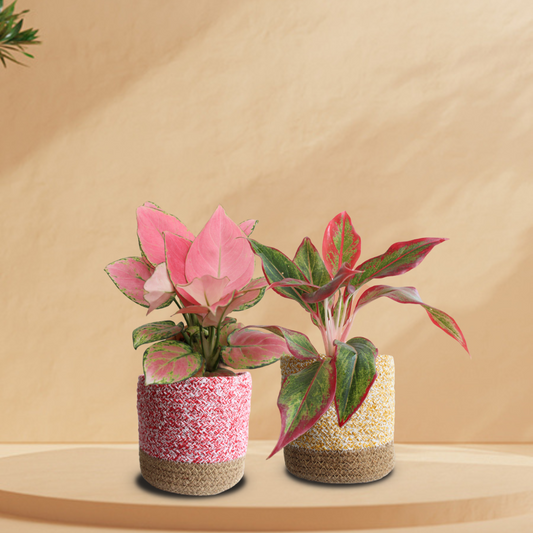
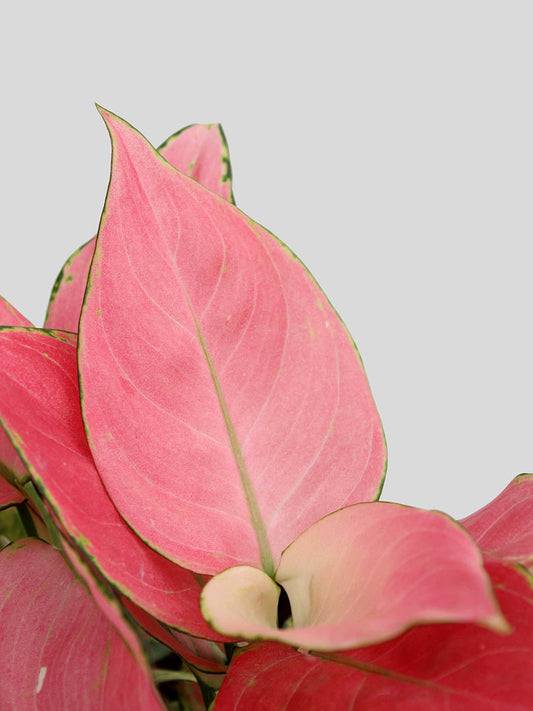 33% Off
33% OffRosy Pink Duo
Regular price ₹ 1,699Regular priceUnit price per₹ 2,549Sale price ₹ 1,699Sale -
Aglaonema 'O' Rose Cochin Plant in Ceramic Pot (Medium)
Regular price ₹ 1,919Regular priceUnit price per₹ 2,399Sale price ₹ 1,919Sold out
Let customers speak for us
Buy Aglaonema Plants Online
Some Aglaonema varieties have green leaves, while others have white, crimson, red, or pink leaves in eye-catching patterns that are ideal for decorating contemporary homes, workplaces, & living rooms. The colorful Aglaonema plants have become a much-revered houseplant across the world.
Aglaonema plant thrives in low-light conditions but requires moist soil, protection from cold temperatures & excessive sunlight. According to the NASA Clean Air Study, the species modestum of the Aglaonema plant genus was good at getting rid of formaldehyde & benzene, which are common household air pollutants. Aglaonema plant is an ideal popular choice for those seeking a unique, appealing, and effective indoor plant for homes, greenhouses, offices, hotels, & shopping malls for interior designing.
History & Origin of the Aglaonema Plant
Aglaonema, a member of the Araceae family, is native to southeast Asia. It is a genus of about 40 species that is known for its unique patterns on its leaves as well as flowering plants.
Aglaonema plants have been grown for hundreds of years in Asia as lucky plants. The Aglaonema plant was first introduced to the West in 1704 by Camellus, a Jesuit priest in the Philippines.
Aglaonemas grow wild in subtropical rainforests of Thailand, Indonesia, & Malaysia, where they are happy beneath larger trees & shrubs that keep the sun from reaching them. The plant belongs to the Araceae family, which includes around forty species. Indigenous Aglaonemas have variegated leaves & are generally small.
Morphology of the Aglaonema Plant
With over 100 varieties, Aglaonema plants offer a range of vibrant colors and patterns, from light green to silver to yellow to red. Aglaonema consists of soft-caned herbaceous perennial plants, ranging in height from 30-150 cm. The leaves of the Aglaonema plant are evergreen, ranging from 10-45 cm in length & 4-16 cm in width. The foliar variegation and color are variable, with leaves being medium to dark green or variegated in lovely hues of greens, silver, or whites. The sheer number of varieties gives plant enthusiasts a wide choice of selection when buying aglaonema online.
The flowers of the Aglaonema plant are arranged modestly beneath the leaf, which develops in an ear enclosed by a bract. The spadix of the plant bears female flowers positioned at its base, while the male flowers, adorned with lustrous filaments, are elevated above. The flowers of this plant are merely unimpressive & should be removed so as not to impede from its aesthetic appeal.
Interesting Facts of the Aglaonema Plant:
- The Aglaonema plant is used many times in the hit film ‘Léo’, where the eponymous hero treasured it & Mathilda gave the plant a “fresh start” at the end of the film.
- Aglaonema is a visually appealing decorative plant. But this plant is toxic in nature due to calcium oxalate crystals, which can cause irritation of mucous membranes & skin irritation & painful rash when ingested orally. So simply put, do not eat the plant!
Cultivation of the Aglaonema Plant
There are more than 100 different varieties of Aglaonema plants that can be grown indoors. They are known for having beautiful leaves with slight stripes in colors like pale green, silver, yellow, red, & other vivid colors & patterns. Cultivation procedures vary significantly among varieties but are generally similar.
How to grow Aglaonema plant at home?
Aglaonema can be propagated through stem cuttings or through division when repotting.
To propagate using stem cuttings, proceed as follows:
- To grow new plants from stem cuttings, cut a few-inch stem from the mother plant with a very sharp, clean knife.
- Put the cutting in a glass of water & put the bottom end in root hormone.
- Make sure the cutting is not directly in the rays of the sun.
- After three to four weeks, the cutting will have roots. Repot it at this point.
To multiply by division, follow the below steps:
- Place the pot on its side so that you can take out the plant & its dirt.
- Carefully pull the tumbling mass of roots & soil apart.
- Hold the plant near the roots and divide the stem shoots by breaking the bond between different shoots. Note that each divided shoot should have some roots with it.
- Fill a pot with warm water & loose planting soil. Place the clump in it.
- For a couple of weeks, keep both the original & the three offspring moist until they are settled & less stressed.
Benefits & Uses of the Aglaonema Plant
- Aglaonema plants are visually pleasing: Leaves of Aglaonema, which are available in a variety of colors & patterns, are selected for their aesthetic value. They are easily adaptable to enhance the look of a space with any decor style.
- Aglaonema is easy to grow & low-maintenance plant: Aglaonema plants are easy to grow & require minimal maintenance, making them a convenient choice for people with hectic schedules. They are compact & slow-growing, only needing to be repotted every three years.
- Aglaonema plants have an easy propagation: Aglaonema can be easily propagated through stem cuttings in water or soil. If you want to share this plant with friends or family, new plants can be started with stem cuttings put into water, or simply by dividing established plants.
- Aglaonema plant tolerates low-light conditions: Some green varieties of aglaonema are able to thrive in rooms with low levels of natural light, making them a great choice for those spaces that lack windows.
- Aglaonemas are natural humidifiers: Aglaonema is recognized to act as a natural humidifier by releasing water from its leaves into the air, which makes the air around it more humid.
- Aglaonema plant is an allergen-free plant: Aglaonema plants with glossy, smooth leaves do not retain allergen particles in the air, making them an excellent choice for those with seasonal allergies.
- Spiritual benefits of Aglaonema: Aglaonema are good Feng Shui plants. This is because they bring “positive chi (energy)” & are associated with “purity” & “good fortune”. In its native country, the Aglaonema is one of the most popular houseplants in history. In fact, it’s so respected that it’s often placed in business lobbies, temples, various buildings, & sometimes even in homes for good luck in Thailand.
- Aglaonema has air-purifying properties: Aglaonema is another top pick for indoor air purification plant. They’re effective at removing formaldehyde—commonly found in carpeting—from the air and help you to breathe & sleep better! It also helps in removing some harmful VOC (Volatile Organic Compounds) from the air & in return improves air quality by adding oxygen to the environment.
- Therapeutic properties of Aglaonema plant: Research has demonstrated that Aglaonema plants hold psychologically calming & tension-relieving properties. They have also been investigated for possible therapeutic uses, including as a neuroprotective agent & a libido booster.
- Other Health benefits of Aglaonema plants: If you live somewhere cold in the winter & have dry skin, cracked lips, or other winter problems, Aglaonema can help you look & feel better.
- Aglaonema plants are perfect for gifting: Aglaonema plants are exquisite & simple to care for, making them great gifts. With over 100 varieties, they offer a range of vibrant colors & patterns, from light green to silver to yellow to red. Aglaonema is often used as a green decor element in offices, hotels, & public spaces as well as in interior landscaping. It becomes a popular gift during housewarmings, birthdays & other occasions.
Learn how to decorate your home with Aglaonema plants
Growing and care guide for Aglaonema - What to avoid & adopt
Aglaonema plants are extremely easy to care for. They are hardy indoor plants that need little upkeep. Some varieties of Aglaonema plants are more tolerant than others. Follow the below guide to understand the general principles to follow for keeping your Aglaonema plant healthy.
Aglaonema Plant Care - What To Adopt:
- All plants of Aglaonema types, on average, require medium-bright & indirect light (moderate lighting with shade or morning sunlight).
- Choose well-draining peat-based potting mix & mildly acidic soil (6.0–6.5 pH).
- Wait for the soil to dry out before watering, but don't overwater because extreme moisture can damage the roots of the Aglaonema plant.
- Aglaonema plant thrives in 65–90°F (18–32°C) indoor temperatures with little light & humidity.
- Winter care for Aglaonema involves monitoring for chilling injury, which can occur at temperatures between 32-59°F (0-15°C).
Aglaonema Plant Care - What To Avoid:
- Avoid placing the aglaonema plant in an area exposed to wind, chill, or air conditioning to prevent chilling injury. Mature & old leaves are more sensitive to chilling temperatures.
- The Aglaonema plant can be toxic to pets & children if ingested, so keep it out of reach.
- Do not overwater the aglaonema plants. Overwatering causes yellow leaves, stem rot, and root rot.
Read more: Pink Aglaonema Care Guide
Varieties of Aglaonema Plants
Aglaonema is a genus of evergreen tropical perennials indigenous to the humid tropical regions of Asia. The Aglaonema plant is available in various varieties with different colors & patterns on the foliage of the plant. Below are a few varieties of the best Aglaonema plants that you can buy online:
- Aglaonema Pink Anjamani: It has beautiful red-pink & green foliage. It is simple to care for & endures a wide range of climatic conditions. Its vibrant foliage is a welcome addition to any space.
- Aglaonema Milky Way: It has long, silver-gray & apple-green leaves which have a gold-and-yellow center vein. The plant's minimum care requirements & its tolerance of neglect make it an ideal choice for beginners.
- Aglaonema Red Lipstick: It has a mix of green and red leaves, where real red color dominates most of the plant. Unlike other red varieties where the color is more towards dark pink, red lipstick Aglaonema is the real red Aglaonema.
- Aglaonema Black Lipstick: It has exotic green & bright red-pink foliage with red-pink leaf edges & centers. It is easy to care for & adds color to any room.
- Aglaonema Pink Valentine: It has blush pink & contrasted green foliage with random splashes of blush pink. It is an easy-care plant, which can survive in all kinds of surroundings.
- Aglaonema Pink Dalmatian: It has eye-catching deep red-pink & contrasting green foliage with random splashes of deep red-pink color. It is an easy-care houseplant that loves bright, indirect light & it is a good choice for anyone who loves pink plants.
- Aglaonema 'O' Rose Cochin: The plant has green & light pink blush foliage with an almost neon-like pink center. It is easy to care for & has colorful foliage.
- Aglaonema Harlequin: It is one of the rarest Agloanema plants. It has light green, yellow, & bright pink foliage with yellow splashes on light green leaves & center pink veined leaves. It is the best house plant as it requires very little care & it rejuvenates the room with vibrant pink shades.
- Aglaonema Red Valentine: It has rose-pink & deep green foliage with random splashes of rose-pink shade. It is easy to care for & adds color to a room.
- Aglaonema Super White: This rare variety has a creamish-white color & contrasting dark green foliage with random splashes of creamish-white shade. It is low-maintenance & adds vibrancy to a room.
- Aglaonema Red Ruby: It has a vibrant red color with some dark green foliage. This is a decorative plant that requires less care so can be grown indoors or in a dull outdoor shade area. It is also the best air-purifying plant.
- Aglaonema Red Suksom Jaipong: This rare hybrid variety is a unique plant with red & dark green foliage with small white stems. It is a vigorous growing plant & very easy to care for. It is a very shade tolerant & low maintenance plant, that’s perfect for most home & office environments.
Explore the collection of Aglaonema plant:
For indoor gardening, many people choose Aglaonema plants alone or in combination with other houseplants for their visually beautiful attributes. Greenkin collection comes in several combos of Aglaonema plants, each offering unique features and benefits.
Here are a few examples of Aglaonema plant combo collections: Must-Have Shades of Aglaonema Plants: This trio consists of 3 Aglaonema species - Pink Anjamani (Aglaonema Anjamani), Red Lipstick, and Red Beauty - each boasting their own attractive features that make this collection an ideally popular pick among customers.
Plus, these small indoor plants of Aglaonema varieties are well known for purifying the air while being easy to care for! Colorful Air-Purifying Plants Combo: This combination of plants includes Aglaonema Pink Anjamani and Red Lipstick along with other air-purifying species such as Peace Lily and Anthurium that not only look lovely but are also effective at purifying air inside homes. Bedroom Plants Combo for Better Sleep: NASA recommended these three plants - Aglaonema (Pink Anjamani), Spathiphyllum (Peace Lily), and Golden Pothos (Money Plant) that help improve indoor air quality.
Additionally, these plants also contribute to a more restful night's sleep, and provide a tranquil and stress-reducing atmosphere in your home and workplace. >Easy-Care Air-Purifying Indoor Plants Combo
Aglao Valentines Duo: The Indoor Desk Duo consists of Jade Green Plant and Aglaonema Anjamani. This pair includes pink and green plants. When these colors are combined, it creates a visually striking effect while also calming the surrounding area.
Good Luck Charm Easy Care Plants Combo: A beautiful and auspicious addition to any home, this Good Luck Charm Combo has three plants in varying hues of green, golden, and cream. One of these plants is a common Aglaonema plant, along with a Jade plant plus a Money plant, which is thought to attract good wealth and prosperity. Each plant comes in its own pot with a tray, making it an ideal decorative item for those who follow feng shui and vastu. Indoor Desk Duo: The Indoor Desk Duo pair includes Aglaonema Anjamani and Jade Green Plant. This pair contains green and pink plants. When this color combo is placed together makes an aesthetic statement while simultaneously soothing our environment. This combo not only looks beautiful but has proven effective at helping create a calm environment.
Aglaonema Plant Placement: Planting on "Best Spot" & "Garden Type"
The best planting locations for Aglaonema (Chinese Evergreen) include indoor environments, container gardening, shade gardens, tropical houseplant gardens, office or workspace environments, & landscaping. For example:
- Beautiful foliage plants of the Aglaonema species grow well in low-lighting conditions (or partially shaded areas), making them ideal houseplants or office plants. This partial shade-loving plant is suitable for placing at a desk, a shelf, & open areas to boost greenery & purify the atmosphere.
- Aglaonema can be grown in hanging baskets, terrariums, or vertical gardens for unique looks, miniature gardens, or vertical arrangements, providing a stylish & space-saving addition to your home.
- Gardening enthusiasts can use Aglaonema to landscape by putting it under trees, along shady edges, & in areas with some shade.
- Plus, decorative pots can boost the visual value of your home by matching or contrasting with your existing decor.
Gifting Ideas of the Aglaonema Plant
Aglaonema plants are symbolic of “good luck”, “prosperity” & “longevity”. It is a “symbolic gesture” that shows “goodwill & positivity” on various occasions.
An “ideal choice for gifting” on housewarming, birthdays, weddings, new beginnings, corporate gifts, get well soon, condolence, thank you, corporate events, holiday gifts, retirement, anniversary occasions & more.
Additionally, an attractive pot with a “personalized message or card” as well as “care instructions” can make the plant appealing and decorative plants to givers.
Continue Reading: List of Plants that bring Positive Energy
FAQ
Aglaonema plants are perfect houseplants as they are easy to care for. Aglaonemas are an evergreen tropical plant.
Aglaonema plants are the best indoor plants. Aglaonemas should not be kept in direct sunlight.
Aglaonema plants are commonly easy to maintain and make homes healthier by improving air quality and so are popular. Aglaonemas are said to make the air quality better by removing VOCs.
Aglaonemas can produce flowers. Although the plant produces minimal flowers once or twice a year.
No, Agaloenema plants can be toxic to pets. Upon ingestion these plants can be harmful to cats and dogs.
Yes, the Aglaonema plant can be kept in the bedroom. The plant has air purifying properties and having greenery around will help you sleep better.
Yes, Aglaonema plants are generally good for offices. They help to keep the office space fresh and inviting.
Yes, Aglaonema plants are a great choice for balconies. Make sure the plant receives indirect bright light. Too much sunlight can burn the leaves.
Yes, Aglaonema Plants are oxygen plants. Aglaonema plants give Oxygen during the day during photosynthesis.
There are many different Types of Aglaonema plants. Aglaonemas are also called Chinese Evergreen Plants.
Yes, Aglaonemas are considered positive according to both Vastu and Feng Shui. These plants are said to bring good luck, prosperity and abundance.
Aglaonema plants prefer slightly moist soil. Water the plant once or twice every week for healthy growth.
The Aglaonema plant needs indirect bright sunlight to thrive happily. Aglaonemas do not like direct sunlight as it will burn the leaves of the plant.
Aglaonemas do not need heavy fertilising. You can feed fertiliser to your Aglaonema plant during the growing season.
The Aglaonema plant likes a temperature range of 18 to 27°C. The plant thrives in tropical and subtropical climates.
Aglaonemas help in removing Formaldehyde from air indoors. The plant is also said to bring good luck according to Feng Shui.
Yes, pruning ensures that the plant maintains its shape. Pruning also contributes to new fresh growth of the plant.
Aglaonema plants can be grown easily by stem cuttings. Aglaonema plants are easy to grow and maintain.
No, Agaloenema plants belong to the family of Arums. The croton plant belongs to the Spurges family.
Yes, Aglaonemas are a beginner friendly plant option. Aglaonemas are easy to take care of and take minimal maintenance.
Yes, Aglaonema plants are a great choice for gifting since they represent positivity and abundance. Thus, making them one of the best plants to give.
Yes, if the soil is left moist Aglaonema can survive more than 10 days without water. Although you must water your Aglaonema plant more during summers.
Keeping green plants around helps in increasing positivity and reduces stress. Aglaonemas help in improving mental wellbeing by removing VOCs.
Yes, Aglaonemas can be used for garden landscaping, if planted in shaded areas with indirect sunlight. Direct sunlight may burn the leaves of the plant.
Yes, the leaves of the Aglaonema plant come in a shade of red or pink dappled over the green leaves. The Aglaonema plant purifies the air by removing benzene and Formaldehyde.
If Aglaonema plant leaves have dry tips that can indicate that the plant is receiving less water so you should regulate the watering frequency. Also check the sunlight the plant is receiving.
If The leaves of your Aglaonema plant are turning yellow, provide the plant with sufficient levels of sunlight. Also keep an eye on the Pot in which the plant has been planted. Make sure the pot has enough drainage holes.
Aglaonema plant belongs to the native region of tropical and subtropical climates of Asia and New Guinea. So mimicking the same climate helps the plant to grow easily.
There are many types of Aglaonema plants, ranging from common and cheaper varieties to more rare and costlier varieties. Also, healthier Aglaonema plants are costlier than the ones which have damaged leaves due to fungal infection.
The Aglaonema plant is also known by the names of Chinese evergreen plants. Due to its exquisite foliage, the plant is a popular choice for keeping indoors .
Yes, Aglaonema plant can be used for biopic designing. Keeping greenery indoors helps to Keep mental health in check.
Although no proven research says that Aglaonema plants can successfully remove air spores. Aglaonema plants can help remove formaldehyde or benzene from air.
Aglaonema plants can typically grow up to a height of 1 to 3 feet tall. Aglaonemas are easy to maintain and thrive on minimal care.
Certainly! If you want to save space and grow your Aglaonema plant in a basket you can go ahead and do that. Aglaonema plants can also be grown in terrariums or vertical gardens.
Aglaonemas can survive for 30 to 35 years with proper care. The plant has its watering and sunlight requirements but is surely very rewarding.
Aglaonema Are also known by the name of Chinese Evergreen plants. According to Feng shui, the plant is a symbol of prosperity and good financial health.
Yes, Agloenama plants can live up to thirty years and are Long living. The plant is a good houseplant choice.
Aglaonema plants are said to bring in good luck and prosperity. The plant is recommended to be kept Indoors, according to both vastu and feng shui.
If the leaves of your Aglaonema plants are drooping check if the plant is receiving proper sunlight or if it is being watered properly. Regulate the watering frequency based upon the climate and season.
Aglaonemas are different from money plants. Aglaonema belongs to the Arums family.
Agloenama plants browning can be a sign of burning. The plant is either rotting at the root or is getting excessive amounts of sunlight, either of which should be avoided.
If you notice the Aglaonema plant wilting, the plant is receiving too much water. Avoid overwatering the plant and select a planter with proper drainage holes.
Yes, Aglaonema plants can be planted in pots. Aglaonema is an ideal choice for a house plant.
Aglaonema plants, if taken proper care, last for more than 30 years. It roughly depends on plant health and how long it will live.
Aglaonema plants can sometimes overcrowd. Treat this problem by repotting, pruning or dividing the plant into subsections.
Yes, Aglaonema plants can help you sleep better. Keeping greenery around helps in regulating the sleeping cycle.
Aglaonema plants do well with twice or thrice a week watering frequency. Watering needs depend on the climate and the seasonal changes, if any.
Wipe the leaves of your Aglaonema plant gently with a cloth occasionally. The leaves can gather dust on top after some time.
Treating pest infestations in Aglaonema plants can be done by keeping the plants free of dust. Use neem oil if the problem persists.
Aglaonema plants need to be repotted once they have outgrown their containers. Also, if the soil is getting waterlogged consider repotting your plant.




